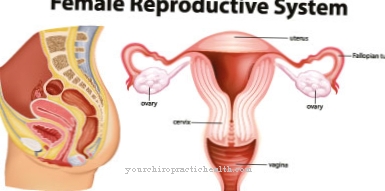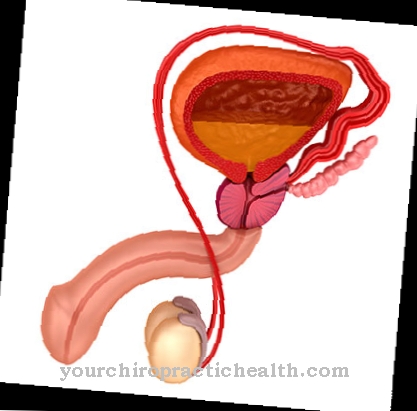At a Liver fibrosis Pre-existing diseases lead to the breakdown of healthy liver tissue, which is replaced by collagenous connective tissue. This scarring often forms a transition stage to liver cirrhosis.
What is liver fibrosis?
Fibrosis is the medical name for an increase in connective tissue within an organ. In case of a Liver fibrosis Functional liver tissue is replaced by collagenous connective tissue (scar tissue). Usually this is an irreversible process, so that the liver tissue can no longer recover from the fibrosis. If there is severe liver fibrosis, it is also called cirrhosis of the liver.
causes
Liver fibrosis is not an independent disease. Instead, it is a symptom that arises from various previous illnesses. One of the most common triggers of liver fibrosis is excessive consumption of alcohol. The breakdown of alcohol from the body is done in the liver.
However, the constant exposure of this important organ to alcohol can result in fatty liver disease. While fatty liver is sometimes still reversible at an early stage, more fibroblasts develop in the later stage. This means cells that produce connective tissue.
They are ultimately responsible for the development of liver fibrosis. The liver tissue can then no longer regenerate. Not only alcohol is responsible for the development of fatty liver and liver fibrosis, but also the excessive use of drugs such as steroid hormones.
Other possible reasons are obesity (obesity) and diabetes (diabetes mellitus). Viral hepatitis is also one of the frequent triggers of liver fibrosis. It is mostly caused by the hepatitis B and hepatitis C viruses.
The viruses cause inflammation of the liver tissue, which has a harmful effect on healthy tissue. If the liver inflammation lasts longer than six months, doctors speak of chronic hepatitis. In the course of this, the healthy liver cells are displaced by the fibroblasts. The formation of connective tissue eventually leads to liver fibrosis.
If the fibrosis continues for years, there is a risk of liver cirrhosis. Other possible causes of liver fibrosis are chronic congestive hepatitis, which is often caused by right heart failure, prolonged toxic effects on the liver, alpha-1 antitrypsin deficiency and chronic cholestasis.
Symptoms, ailments & signs

© wowow - stock.adobe.com
There are hardly any typical symptoms of liver fibrosis. It is not uncommon for her to have no symptoms at all. So it is with her a disease stage that is not yet too pronounced. Symptoms that indicate liver disease are often only noticeable in liver cirrhosis.
In some cases, symptoms of liver fibrosis are atypical, such as loss of appetite, loss of weight, fatigue, bleeding disorders and frequent bleeding of the gums. Some patients also have an incompatible reaction to alcohol. These signs do not automatically think of liver disease, however, because they can also indicate other diseases.
More obvious symptoms of liver disease do not manifest themselves until the advanced stage. One of these is jaundice (jaundice), in which the patient's skin and eyes turn yellow. Some patients also experience itching all over their bodies.
Diagnosis & course of disease
The doctor can use several examination options to diagnose liver fibrosis. Sonography (ultrasound examination) is a tried and tested method. With this procedure, the structure increase in the liver can be recognized, but this often happens too late because the patient usually only decides to seek medical treatment when symptoms appear.
The examination methods also include an analysis of the blood. Collagen IV and elevated liver enzymes suggest liver fibrosis. However, an examination is only useful at an advanced stage. A puncture, during which the doctor removes liver tissue, provides certainty in making the diagnosis.
It is then examined under a microscope. Depending on how far the liver fibrosis has progressed, medicine divides it into different degrees of severity from F0 to F4. In stage F0 there is still no increase in connective tissue in the fibers, while F1 is a low-grade fibrosis. F2 and F3 are classified as moderate and severe fibrosis, respectively.
F4 is an advanced liver fibrosis or liver cirrhosis. The course of liver fibrosis depends on the underlying disease that causes it. In the case of hepatitis, the fibrosis often turns into cirrhosis of the liver. Normally, the liver fibrosis can no longer regress, so that a promising treatment should already start in the case of fatty liver.
Complications
The symptoms and complications of liver fibrosis usually depend heavily on the stage of the disease. If left untreated, however, in the worst case scenario, the affected person can also die, so that the liver fibrosis must definitely be examined and treated by a doctor. The patients often suffer from weight loss and also from anorexia.
Bleeding gums and clotting disorders can also occur. Those affected also do not tolerate alcohol and suffer from jaundice as the liver fibrosis progresses. Itching can also spread throughout the body, which leads to very unpleasant feelings and a strong reduction in the quality of life. The further course of the disease, however, depends heavily on the cause of the liver disease, so that a general prediction is usually not possible.
In most cases, treatment can take place with the help of medication and is mostly based on the symptoms. There are no particular complications. In severe cases, those affected also need a liver transplant. Liver fibrosis may also reduce the person's life expectancy.
When should you go to the doctor?
If signs of liver disease appear, a doctor should be consulted. Symptoms such as loss of appetite, fatigue, bleeding disorders or jaundice indicate fibrosis, which must be examined and, if necessary, medically treated. If this happens early enough, further complications or long-term consequences can be avoided. A doctor's visit is indicated at the latest when external changes or cardiovascular problems occur. People who regularly consume alcohol or take medication should see a doctor quickly if these symptoms occur. People with obesity, diabetes or a viral disease also need to have unusual symptoms clarified immediately, as there is an increased risk of developing liver fibrosis.
The family doctor can make an initial suspected diagnosis and refer the patient to a specialist in liver disease. Further treatment usually takes place in the hospital. A longer hospital stay is necessary for a liver transplant. If the state of health worsens massively during treatment, it is best to inform the emergency services. A specialist center for liver diseases can provide more information about liver fibrosis and support those affected with therapy.
Treatment & Therapy
The treatment of the underlying disease is at the heart of the therapy for liver fibrosis. Treating hepatitis can often stop the fibrosis. Sometimes there is even a regression.
However, it is important to start therapy as early as possible, as this increases the chances of success. So far there is no way of stopping the progression of liver fibrosis with drugs. However, there are now promising experimental therapeutic approaches.
If the patient has advanced fibrosis, treatment is limited to symptom relief. This includes changing your diet, getting enough exercise and relocating the bile ducts. A liver transplant can also be useful in some patients.
You can find your medication here
➔ Medicines for jaundice and liver problemsOutlook & forecast
The course of liver fibrosis depends on various factors. These include the progress of the disease, the constitution of the patient and the type of therapy. The prognosis is worse if there are other diseases. If the cause of the liver fibrosis cannot be determined, no targeted treatment is possible. Symptomatic therapy is not very promising in liver fibrosis, as the symptoms are usually only noticeable in the end stage of the disease. The prognosis depends on the underlying disease.
Chronic hepatitis can cause liver cirrhosis in the long term. If chronic obstructive cholestasis is the cause, the disease can come to a standstill. Complete recovery is possible through papillotomy. The F-Score also has an influence on the prognosis. The extent of the disease is divided into five levels, with F0 describing incipient liver fibrosis and F4 very advanced liver fibrosis. The higher the score, the more negative the prognosis. The doctor can provide a more precise prognosis. The doctor responsible will take an anamnesis and consider the course of the disease to date. He can also use statistics to support the forecast.
prevention
The causes of liver fibrosis are different and not every trigger can be prevented. However, some forms of fibrosis can be counteracted through moderate consumption of alcohol and medication, as well as reducing excess weight.
Aftercare
In the case of liver fibrosis, follow-up measures are usually severely limited, so that the person affected should primarily consult a doctor. It is a serious illness, so an early diagnosis should definitely be made. This is the only way to prevent further worsening of the symptoms.
If liver fibrosis is not treated properly or treated late, it can even lead to death in the worst case. Most people affected by this disease are dependent on various medications. It is always important to ensure that the dosage is correct and that it is taken regularly. If anything is unclear or if you have any questions, a doctor should be consulted first.
However, if the medication does not work or does not lead to the desired success, a liver transplant is usually necessary. This cannot always be done and is not always successful, so that the life expectancy of the person affected decreases significantly due to liver fibrosis. After an operation, however, the person affected should definitely rest and take care of their body. You should refrain from physical exertion or stressful activities.
You can do that yourself
If liver fibrosis has been diagnosed, the trigger must be determined and treated specifically. Usually the symptoms are based on excessive alcohol consumption, which accordingly has to be stopped or at least greatly reduced. If the cause is an unhealthy diet, the diet must be changed.
A healthy lifestyle generally makes sense, because exercise and a balanced diet strengthen the liver and prevent the liver fibrosis from progressing. People suffering from obesity should reduce their body weight.
Medical treatment is required if serious diseases of the heart or bile are the cause. In consultation with the doctor, specific measures can then be taken to alleviate the symptoms. In general, medicinal supplements that are supported by natural pain relievers and sedatives will help. Naturopathy offers arnica, chamomile and feverfew, among other things. These remedies help with tension headaches and pain in the liver area. The preparations belladonna and aconite can be used in homeopathy. Ointments and creams made from natural substances such as lemon balm or eucalyptus help against itching.
In parallel to this symptomatic treatment, the underlying disease must be treated by a doctor in order to avoid cirrhosis of the liver.



.jpg)























